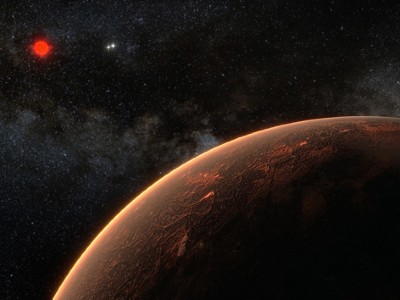
If we know anything at all, it is that stars have plenty of objects orbiting them just like ours. Yet we also have been seeing a lot of close orbits on almost all and likely because of our detection methods. It is just what we can see.
I would like to know how many have a Jupiter size secondary. That determines that the inner orbits will clean up.
That then determines if an Earth like planet can exist at all. Or I at least suspect so.. Of course our own system was seriously engineered. That is likely a rarer occurance than our example of one might suggest.
Earth-like planet spotted orbiting Sun’s closest star
Correction 11 February 2022
Shifts in starlight from Proxima Centauri, observed over more than 2 years, reveal its third planet.
An artist’s impression of the newly discovered planet orbiting Proxima Centauri.Credit: ESO/L. Calçada
Astronomers have discovered a third planet orbiting Proxima Centauri, the star closest to the Sun. Called Proxima Centauri d, the newly spotted world is probably smaller than Earth, and could have oceans of liquid water.
“It’s showing that the nearest star probably has a very rich planetary system,” says Guillem Anglada-Escudé, an astronomer at the Institute of Space Sciences in Barcelona, Spain, who led the team that, in 2016, discovered the first planet to be seen orbiting Proxima Centauri.
Astronomer João Faria and his collaborators detected Proxima Centauri d by measuring tiny shifts in the spectrum of light from the star as the planet’s gravity pulled at it during orbit. The team used a state-of-the art instrument called the Echelle Spectrograph for Rocky Exoplanets and Stable Spectroscopic Observations (ESPRESSO) at the Very Large Telescope, a system of four 8.2-metre telescopes at the European Southern Observatory in Cerro Paranal, Chile. The results were published on 10 February in Astronomy & Astrophysics1.
This ‘wobble’ technique look for changes in the star’s motion along the line of sight from Earth; ESPRESSO can detect variations of just 10 centimetres per second. The total effect of the planet’s orbit, which takes only 5 days, is about 40 centimetres per second, says Faria, who is at the Institute of Astrophysics and Space Sciences of the University of Porto in Portugal. “I knew that ESPRESSO could do this, but I was still surprised to see it showing up.”
To find the wobble, the team made more than 100 observations of Proxima Centauri’s spectrum over a little more than 2 years. ESPRESSO is kept in a special room at the observatory, inside a tank that keeps its pressure and temperature constant. This ensures that its measurements are consistent and repeatable over years. ESPRESSO can measure the wavelength of spectral lines with a precision of 10−5 ångströms, or one-ten-thousandth of the diameter of a hydrogen atom, Faria says.
Provisional planet
So far, researchers consider Proxima Centauri d only a ‘planet candidate’: astronomers conventionally wait for independent confirmation before officially introducing a new world into their catalogues. But the ESPRESSO team has high confidence in the detection, says Faria. From its effects on the star’s spectrum, the team estimates that the planet is probably smaller than Earth, but no less than 26% of our planet’s mass.
ESPRESSO was built mainly to search for extrasolar planets, as well as to study light from extremely bright but distant objects called quasars. The most exciting thing about the latest discovery is that it shows that the instrument works as advertised, says Anglada-Escudé. “ESPRESSO is the new instrument which everyone wants to use and play with,” he says.
Proxima Centauri has a special place in astronomers’ hearts, he adds. “It always has a little bit of mystique, being the closest one.”
“It is fascinating to know that our Sun’s nearest stellar neighbour is the host to three small planets,” says Elisa Quintana, an astrophysicist at NASA’s Goddard Space Flight Center in Greenbelt, Maryland. “Their proximity make this a prime system for further study, to understand their nature and how they likely formed.”
Faria admits that even though interstellar travel is still in the realm of science fiction, the dream that people could one day visit our nearest star motivates him to look for Earth-like planets there. “It does make you wonder,” he says.
doi: https://doi.org/10.1038/d41586-022-00400-3

No comments:
Post a Comment